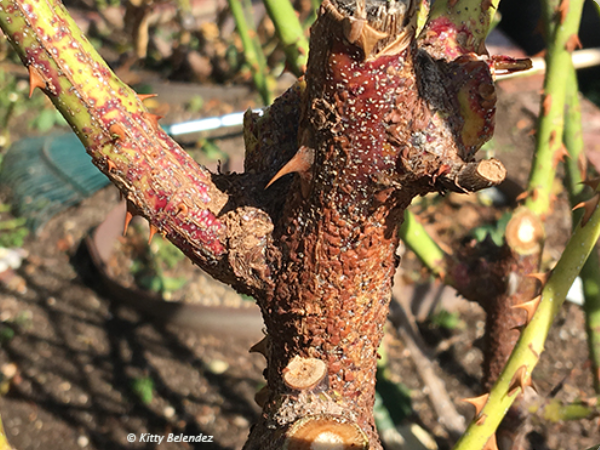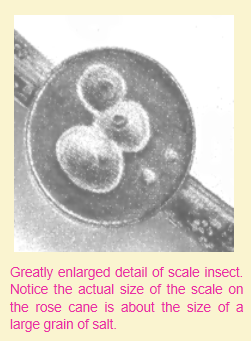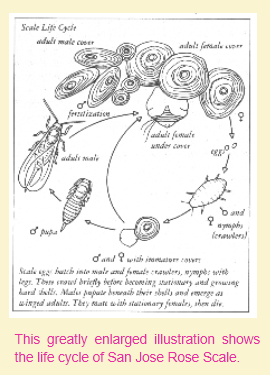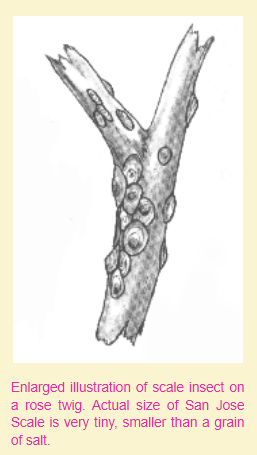Yikes! It’s Scale Insects
San Jose Scale: A Very Destructive Rose Pest

I usually do not spray any chemicals on my roses during the hot summer months. I do, however, spray fungicide and insecticide for six weeks prior to the spring and fall rose show seasons. This ensures beautiful, clean roses. Occasionally, if I see a problem like cucumber beetles, I will apply one application of insecticide during July. But, this year it did not seem to be necessary, and
besides with the temperatures soaring up to 117 degrees I was not inclined to go into the garden much, except to water and wash off the foliage. At a glance, I did not detect any problems.
Unfortunately, when we started to lightly prune for the fall rose shows, I noticed a strange-looking substance on the canes of my Playboy tree rose. I looked in all my rose books to see what it was. I suspected rose scale, but the descriptions and pictures in all my books just did not look like it. Rodale’s Garden Problem Solver and even the ARS Consulting Rosarian Manual had very little to say about scale. The Reader’s Digest Illustrated Guide to Gardening from 1989 had pictures that came close to looking like the scale I had.
Once I started pruning Playboy it was evident that many of the canes were turning gray and black, and in fact were dying. In a panic, I emailed Baldo Villegas who is an expert entomologist (now retired) with the California Department of Food and Agriculture in Sacramento and a respected and knowledgeable Consulting Rosarian. My message began, “HELP! STRANGE ROSE MALADY!” I described how this stuff looked: a gritty, grey, sandy-looking coating on all the rose canes.
Baldo answered my email SOS right away, and from the description, he said it sounded indeed like scale. He asked me to send some samples to him. So I cut off some stems of Playboy rose and packaged them as Baldo instructed, and mailed them to him the next day. In the meantime, Baldo instructed me to immediately spray Ortho systemic insecticide (Orthene) on the infected rose bush which I did that very same day.
The following week, Baldo phoned me to say that it was not just “rose scale,” but in particular it was “San Jose Scale” which usually is found on fruit trees and is the most destructive type of scale. I did have a peach and plum tree but upon inspection I determined that the scale insect was not on them, just on my roses.

Meanwhile, as we continued our fall rose pruning, we discovered to our dismay that this scale damage was on about a dozen of my rose plants. They seemed to favor the very thorny old garden roses, such as Marchesa Boccella, and Baronne Prevost, but they also got on one miniature, a floribunda, and a few hybrid teas including Crystalline.
Until then, I have never seen scale in my rose garden in the many years I have been growing roses. I have gone to many Consulting Rosarian seminars but have heard very little about this strange creature.
On the Sunday night rose exhibitor’s chat group on America Online I asked some of the other participants if they ever had scale on their roses. To my surprise, many had an outbreak just like me that year.
We made a second application of Orthene to the infected rose bushes, and then a third application two weeks later. Additionally, we scrubbed the infected canes with a plastic vegetable brush. This helped to remove the critters, which cling tightly to therose canes even after the scale insects are dead. After we pruned our roses in winter, we made two applications of SunSpray horticultural oil. Even still, we lost about a dozen rose bushes that year, as the San Jose scale had completely killed them.

A few months later, Baldo Villegas, the entomologist from Sacramento, sent an email to me in which he asked me to send another sample of a rose stem from my garden so that he could see if I have gotten the San Jose rose scale under control. I had already pruned my roses in January, but managed to cut a few samples and sent them to Baldo right away. A few days later he contacted me to say that the residue on the samples indicated that the scale had been controlled and that his associate was jumping with joy because he discovered under the microscope that there were “good” parasites now attacking the scale. Baldo said that his associate was so ecstatic with this “find” that Baldo had to tell him to “get a life.”
According to Ortho’s book on Controlling Lawn & Garden Insects, “Destructive scale insects often go undetected. They camouflage themselves beneath shells and do not move. San Jose scales are grayish or brownish pinhead-sized bumps. In large infestations, they may completely encrust the branches of fruit and ornamental trees and shrubs. They are disc-like in shape, and each has a tiny yellow nipple in the center. Under the coverings of shells, the sac-like females are bright yellow. They produce two to six generations a year, depending upon the climate.”

Scales are among the most difficult insect pests to control, especially San Jose Scale. The key to controlling them is to apply pesticides when the crawlers are moving about the infested plants. You will have the best results with a systemic such as Orthene Systemic Insect Control. This has some effect against mature scales because plants absorb the pesticide and deliver it to the feeding scales through sap. Spray three times at 7 to 10 day intervals. It is also recommended to use a dormant spray in the winter using a Horticultural Oil (preferred), or Volck Oil Spray (2nd choice), and infected canes should be removed.
Unlike other insects, scales do not disappear after they have done their damage. Living or dead, they remain attached to the plant; you can scrape the dead ones off easily with a fingernail.
We used to SunSpray horticultural oil after we prune all of our roses in the winter. But that product is no longer available so you will need to search for an appropriate replacement oil. We do this every year. This has been very effective in keeping San Jose Scale insects out of my garden.
NOTE: SunSpray oil is no longer available, but there are other similar brands of dormant oil available at garden stores & nurseries, and are now listed as “petroleum oil.”
This article is an American Rose Society Award of Merit winner. Reprinted from “Rose Ecstasy,” bulletin of the Santa Clarita Valley Rose Society, Kitty Belendez, Editor.
